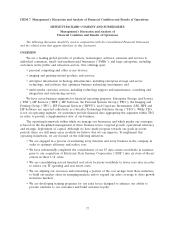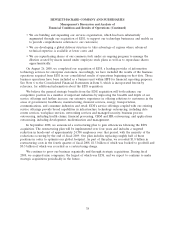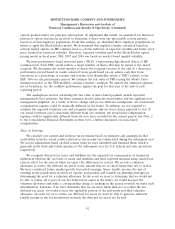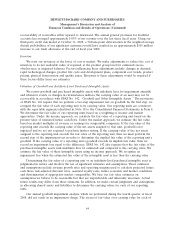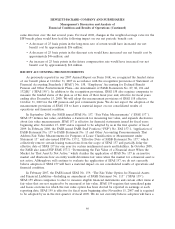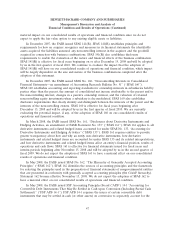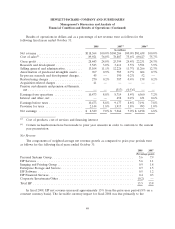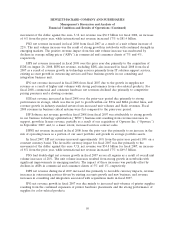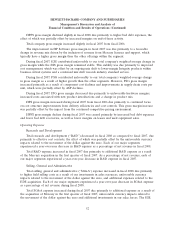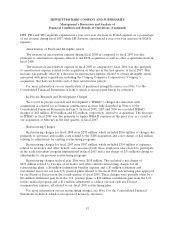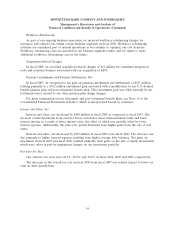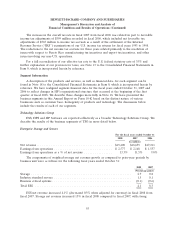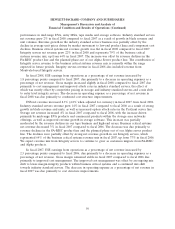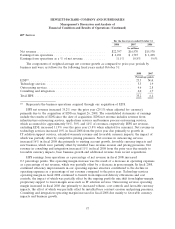HP 2008 Annual Report Download - page 53
Download and view the complete annual report
Please find page 53 of the 2008 HP annual report below. You can navigate through the pages in the report by either clicking on the pages listed below, or by using the keyword search tool below to find specific information within the annual report.HEWLETT-PACKARD COMPANY AND SUBSIDIARIES
Management’s Discussion and Analysis of
Financial Condition and Results of Operations (Continued)
material impact on our consolidated results of operations and financial condition since we do not
expect to apply the fair value option to any existing eligible assets or liabilities.
In December 2007, the FASB issued SFAS 141(R). SFAS 141(R) establishes principles and
requirements for how an acquirer recognizes and measures in its financial statements the identifiable
assets acquired, the liabilities assumed, any noncontrolling interest in the acquiree and the goodwill
acquired in connection with business combinations. SFAS 141(R) also establishes disclosure
requirements to enable the evaluation of the nature and financial effects of the business combination.
SFAS 141(R) is effective for fiscal years beginning on or after December 15, 2008 and will be adopted
by us in the first quarter of fiscal 2010. We continue to evaluate the impact that the adoption of
SFAS 141(R) will have on our consolidated results of operations and financial condition, which impact
will be largely dependent on the size and nature of the business combinations completed after the
adoption of this statement.
In December 2007, the FASB issued SFAS No. 160, ‘‘Noncontrolling Interests in Consolidated
Financial Statements—an amendment of Accounting Research Bulletin No. 51’’ (‘‘SFAS 160’’).
SFAS 160 establishes accounting and reporting standards for ownership interests in subsidiaries held by
parties other than the parent, the amount of consolidated net income attributable to the parent and to
the noncontrolling interest, changes in a parent’s ownership interest, and the valuation of retained
noncontrolling equity investments when a subsidiary is deconsolidated. SFAS 160 also establishes
disclosure requirements that clearly identify and distinguish between the interests of the parent and the
interests of the noncontrolling owners. SFAS 160 is effective for fiscal years beginning after
December 15, 2008 and will be adopted by us in the first quarter of fiscal 2010. We are currently
evaluating the potential impact, if any, of the adoption of SFAS 160 on our consolidated results of
operations and financial condition.
In March 2008, the FASB issued SFAS No. 161, ‘‘Disclosures about Derivative Instruments and
Hedging Activities, an amendment of FASB Statement No. 133’’ (‘‘SFAS 161’’). SFAS 161 applies to all
derivative instruments and related hedged items accounted for under SFAS No. 133, ‘‘Accounting for
Derivative Instruments and Hedging Activities’’ (‘‘SFAS 133’’). SFAS 161 requires entities to provide
greater transparency about how and why an entity uses derivative instruments, how derivative
instruments and related hedged items are accounted for under SFAS 133 and its related interpretations,
and how derivative instruments and related hedged items affect an entity’s financial position, results of
operations and cash flows. SFAS 161 is effective for financial statements issued for fiscal years and
interim periods beginning after November 15, 2008 and will be adopted by us in the second quarter of
fiscal 2009. We do not expect the adoption of SFAS 161 to have a material effect on our consolidated
results of operations and financial condition.
In May 2008, the FASB issued SFAS No. 162, ‘‘The Hierarchy of Generally Accepted Accounting
Principles’’ (‘‘SFAS 162’’). SFAS 162 identifies the sources of accounting principles and the framework
for selecting the principles used in the preparation of financial statements of nongovernmental entities
that are presented in conformity with generally accepted accounting principles (the GAAP hierarchy).
Statement 162 became effective November 15, 2008. We do not expect the adoption of SFAS 162 to
have a material effect on our consolidated results of operations and financial condition.
In May 2008, the FASB issued FSP Accounting Principles Board (‘‘APB’’) 14-1 ‘‘Accounting for
Convertible Debt Instruments That May Be Settled in Cash upon Conversion (Including Partial Cash
Settlement)’’ (‘‘FSP APB 14-1’’). FSP APB 14-1 requires the issuer of certain convertible debt
instruments that may be settled in cash (or other assets) on conversion to separately account for the
47


